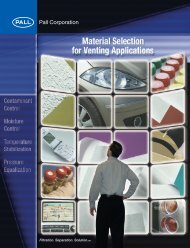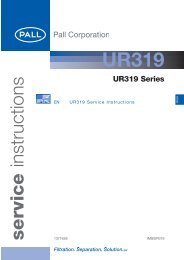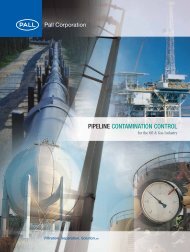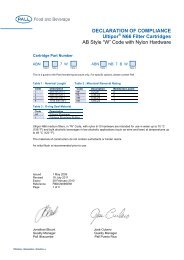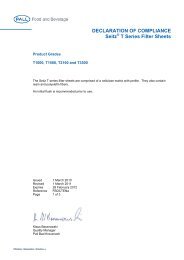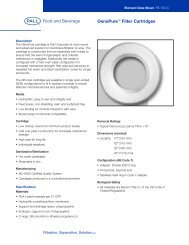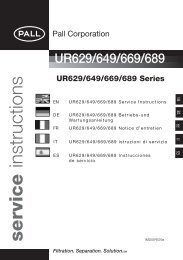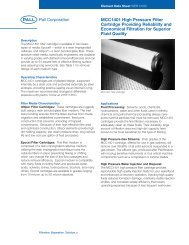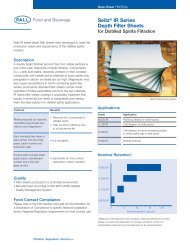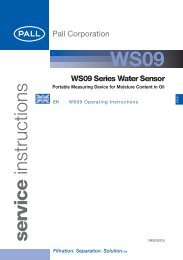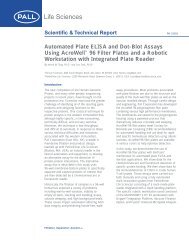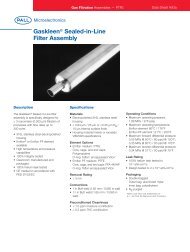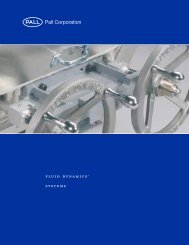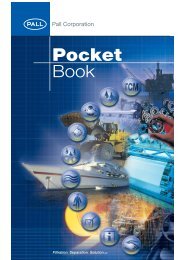POCKET BOOK_Final_Turned - Pall Corporation
POCKET BOOK_Final_Turned - Pall Corporation
POCKET BOOK_Final_Turned - Pall Corporation
- No tags were found...
You also want an ePaper? Increase the reach of your titles
YUMPU automatically turns print PDFs into web optimized ePapers that Google loves.
ISO 4406 Cleanliness Code 17/15/13Sample Volume: 100 mLMagnification: 100xScale: 1 division = 10 µmParticle Count SummarySize Particle Count ISO NAS1638Range per mL 4406 (SAECode AS4059)>4 µm(c) 640 - 1,300 17 7>6 µm(c) 160 - 320 15 7>14 µm(c) 40 - 80 13 7Photo AnalysisVery little contamination is present.The visible particle is black metal.ISO 4406 Cleanliness Code 20/17/15Sample Volume: 100 mLMagnification: 100xScale: 1 division = 10 µmParticle Count SummarySize Particle Count ISO NAS1638Range per mL 4406 (SAECode AS4059)>4 µm(c) 5,000 - 10,000 20 10>6 µm(c) 640 - 1,300 17 9>14 µm(c) 160 - 320 15 9Photo AnalysisLittle contamination is present.The visible contamination is silica and black metal.7
ISO 4406 Cleanliness Code 20/19/16Sample Volume: 100 mLMagnification: 100xScale: 1 division = 10 µmParticle Count SummarySize Particle Count ISO NAS1638Range per mL 4406 (SAECode AS4059)>4 µm(c) 5,000 - 10,000 20 11>6 µm(c) 2,500 - 5,000 19 11>14 µm(c) 640 - 1,300 16 11Photo AnalysisThe visible contamination is mainly silica withsome metallic and rust particles.ISO 4406 Cleanliness Code 21/20/18Sample Volume: 100 mLMagnification: 100xScale: 1 division = 10 µmParticle Count SummarySize Particle Count ISO NAS1638Range per mL 4406 (SAECode AS4059)>4 µm(c) 10,000 - 20,000 21 12>6 µm(c) 5,000 - 10,000 20 12>14 µm(c) 1,300 - 2,500 18 12Photo AnalysisThe visible contamination is mainly silica withsome metallic and rust particles.8
Types of ContaminationSilicaHard, translucent particles often associated with atmosphericand environmental contamination, e.g., sand, dust.Bright MetalShiny metallic particles, usually silver or gold in colour,generated within the system. Generated contaminants areproducts of wear and often cause additional component wearand accelerated fluid breakdown.Black MetalOxidized ferrous metal inherent in most hydraulic andlubricating systems; built-in contaminant and genereatedwithin the system by wear.RustDull orange/brown particles often seen in oil from systemswhere water may be present, e.g., oil storage tanks.FibersContaminants most commonly generated from paper andfabrics, e.g., shop rags.Cake of FinesVery large concentrations of ‘silt’-size particles coat the analysismembrane and build-up into a cake. The cake obscures thelarger particles on the membrane making contaminationevaluation impossible.Magnification: 100xScale: 1 Division = 10 µm9
Water Contamination in OilWater contamination in oil systems causes:• Oil breakdown, such as additive precipitation and oil oxidation• Reduced lubricating film thickness• Accelerated metal surface fatigue• CorrosionSources of water contamination:• Heat exchanger leaks• Seal leaks• Condensation of humid air• Inadequate reservoir covers• Temperature reduction causes dissolved water to turn into free waterOil Temperature (°F)077 122 167100Free Water15010050Dissolved Water0 0 25 50 75Oil Temperature (°C)Ref: EPRI CS-4555 Turbine oilWater Concentration (PPM)To minimise the harmful effects of free water, water concentration in oil should be keptas far below the oil saturation point as possible.10,000 PPM 1%1,000 PPM 0.1%100 PPM 0.01%11
Operating Principle of <strong>Pall</strong> Fluid Conditioning PurifiersPrinciple: Mass transfer by evaporation under vacuumInletcontaminatedfluidVerythinfilmof oilDryairOutletexhaust airVacuum:Expansionof air causesthe RelativeHumidity todecreaseOutletPvacuum-0.7 barInletambient airdry fluidFreeWaterDissolvedWater<strong>Pall</strong> HNP006 Oil Purifier<strong>Pall</strong> Fluid ConditioningPurifiers remove 100% offree water and entrainedgases, and up to 90% ofdissolved water and gasesTypical Applications• Hydraulic oils• Lubrication oils• Dielectric fluids• Phosphate-esters• Quenching fluids12
Water Content Analysis MethodsMethod Units Benefits LimitationsCrackle Test None Quick indicator of Does not permitpresence of free detection belowwatersaturationChemical Percentage or PPM A simple Not very accurate(Calcium hydride) measurement of on disolved waterwater contentDistillation Percentage Relatively unaffected Limited accuracyby oil additives on dry oilsFTIR Percentage or PPM Quick and Accuracy does notinexpensivepermit detectionbelow 0.1% or1,000 PPMKarl Fischer Percentage or PPM Accurate at Not suitable for highdetecting low levels of water.levels of water Can be affected(10 - 1,000 PPM) by additivesCapacitive Sensors Percentage of Very accurate at Cannot measure(Water Sensors) saturation or PPM detecting dissolved water levels abovewater, 0 - 100% of saturation (100%)saturation.WS04 Portable Water SensorWS08 In-line Water Sensor13
Monitoring and MeasurementObtaining accurate and reliable fluid cleanliness data quickly in order to detectabnormal contamination is a key factor in ensuring the efficiency of industrialprocesses and reducing downtime.Reliable Monitoring Solutions... ................................................Whatever the Conditions...Whatever the FluidPCM400WPCM400W Portable Cleanliness MonitorProvides an assessment of system fluid cleanliness• Proven multiple mesh blockage technology.• Results not affected by water or air contamination.• Designed for use with dark or cloudy fluids.• ISO 4406, NAS 1638 or SAE AS4059 data output.PFC400WPFC400W Portable Particle CounterMeasures the size and quantity of particles in industrialsystem fluids• Proven laser light blockage technology.• Measures the size and quantity of particles inindustrial fluids.• ISO 4406, NAS 1638 or SAE AS4059 data output.WS08<strong>Pall</strong> Water SensorThe next generation of in-line monitors for watercontamination in system fluids• Measures dissolved water content as % ofsaturation(%sat) or PPM.• Portable and in-line models.WS0414
Component Cleanliness MeasurementExtraction ExtractionComponent Cleanliness Cabinets facilitate the accurate, reliableand repeatable determination of component cleanliness.PCC030Analysis AnalysisAll stainless steel cabinets feature:• Controlled extraction environment• Automated cleaning to ‘blank’ values• Pressurised solvent dispensing andrecycling circuits.• Meet ISO 18413, ISO 16232 andVDA 19 procedures.PCC041The <strong>Pall</strong> PCC 500 series cabinets combined extraction andanalysis using filter blockage measurement techniques whichare not affected by the presence of water or air in fluids.BlankComponentContaminationPCC500ComponentContaminationMicroscopic AnalysisProcess Process Optimization Optimization• Developing optimization• Developing and validationof cleanliness standard• Cleaner fluids• Laboratory services15
Fluid Sampling ProcedureIntroductionThere are 4 methods for taking fluid samples. Method 1 is the best choice followed byMethod 2. Method 3 should only be used if there is no opportunity to take a line sample,and Method 4 should only be used if all others are impracticable.DO NOT obtain a sample from a reservoir drain valve. Always take the sample under thecleanest possible conditions, and use pre-cleaned sample bottles.If there are no line mounted samplers, fit a <strong>Pall</strong> sampling device to the <strong>Pall</strong> filter.Method 1Small ball valve with PTFE or similarseats, or a test point1. Operate the system for at least 30minutes prior to taking sample in orderto distribute the particulate evenly.2. Open the sampling valve and flush atleast 1 litre of fluid through the valve.Do not close the valve after flushing.3. When opening the sample bottle, beextremely careful not to contaminate it.4. Half fill the bottle with system fluid,use this to rinse the inner surfaces andthen discard.5. Repeat step 4 a second time withoutclosing the valve.6. Collect sufficient fluid to fill 3/4 of bottle(to allow contents to be redistributed).7. Cap the sample immediately and thenclose the sample valve.Caution: Do not touch the valvewhile taking the sample.8. Label the sample bottle with systemdetails and enclose in a suitablecontainer for transport.Method 2Valve of unknown contaminationshedding capabilities1. Operate the system for at least 30minutes prior to taking sample in orderto distribute particulate evenly.2. Open the sampling valve and flush atleast 3 to 4 Litres of fluid through thevalve. (This is best accomplished byconnecting the outlet of the valve backto the reservoir by using flexible tubing).Do not close the valve.3. Having flushed the valve, remove theflexible tubing from the valve with thevalve still open and fluid flowing.Remove the cap of the sample bottleand collect sample according toinstructions 4 to 6 of Method 1.4. Cap the sample immediately and thenclose the sample valve.Caution: Do not touch the valvewhile taking the sample.5. Label the sample bottle with systemdetails and enclose in a suitablecontainer for transport.16
Fluid Sampling Procedure (continued)Method 3Sampling from Reservoirs andBulk ContainersApplicable only if Methods 1 and 2cannot be used1. Operate the system for at least 30minutes prior to taking sample in orderto distribute the particles evenly.2. Clean the area of entry to the reservoirwhere sample will be obtained.3. Flush the hose of the vacuumsampling device with filtered (0.8 µm)solvent to remove contamination thatmay be present.4. Attach a suitable sample bottle tothe sampling device, carefully insertthe hose into the reservoir so that itis mid-way into the fluid. Take carenot to scrape the hose against thesides of the tank or baffles within thetank as contamination may be suckedinto the hose.5. Pull the plunger on the body of thesampling device to produce vacuumand half fill the bottle.6. Unscrew bottle slightly to releasevacuum, allowing hose to drain.7. Flush the bottle by repeating steps 4 to6 two or three times.8. Collect sufficient fluid to 3/4 fill thesample bottle, release the vacuum andunscrew the sample bottle. Immediatelyrecap and label the sample bottle.Method 4Bottle DippingLeast preferred method1. Operate the system for at least 30minutes prior to taking sample in orderto distribute particulate evenly.2. Clean the area of entry to the reservoirwhere sample will be obtained.3. Ensure the outside of the bottle is cleanby flushing with filtered solvent.4. Remove cap from the sample bottle.Carefully fill the sample bottle bydipping it into the reservoir and thendiscard the fluid after rinsing the insideof the sample bottle.5. Repeat step 4.Carefully fill the sample bottle, capimmediately and wipe the outside.6. Secure any openings in the reservoir.Note: Incorrect sampling procedureswill adversely effect the cleanlinesslevel in the sample bottle.It is impossible to make a samplecleaner than the actual system butvery easy to make it dirtier.17
Filter locationFlushing Filter• To remove particles that have been built-into the system during assembly ormaintenance before start-up.• To remove large particles that will causecatastrophic failures.• To extend 'in-service' filter element life.Pressure Line• To stop pump wear debris from travellingthrough the system.• To catch debris from a catastrophicpump failure and prevent secondarysystem damage.• To act as a Last Chance Filter (LCF)and protect components directlydownstream of it.Return Line• To capture debris from component wear oringression travelling to the reservoir.• To promote general system cleanliness.Air breather• To prevent ingression ofairborne particulate contamination.• To extend filter element service life.• To maintain system cleanliness.Kidney loop/off-line• To control system cleanliness whenpressure line flow diminishes(i.e. compensating pumps).• For systems where pressure or returnfiltration is impractical.• As a supplement to in-line filters to provideimproved cleanliness control and filterservice life in high dirt ingression systems.Additional filters should be placedahead of critical or sensitivecomponents• To protect against catastrophic machinefailure (often non-bypass filters are used).• To reduce wear• To stabilize valve operation(prevents stiction).Pressureline filterReturnline filterAirbreatherFluidConditioningPurifierOil transferfilter cartKidneyloop/off-linefilter18
The <strong>Pall</strong> concept of Total Cleanliness Management in practiceWater Supply<strong>Pall</strong> Microfiltrationsystems<strong>Pall</strong> ReverseOsmosisWaterClarification<strong>Pall</strong> AirBreathers<strong>Pall</strong> Cross FlowFiltrationSystemsWaste Disposal<strong>Pall</strong> DT Modulereverse osmosissystemsBulk FluidStorageCoolantWash fluid<strong>Pall</strong> Ultipleat ® SRTOn-line filling filtrationParts Washing<strong>Pall</strong>Melt BlownFilters<strong>Pall</strong> FluidManagementServicesSupplyMachining CentresCoolant Cleanliness<strong>Pall</strong> Filters forthrough tool coolantInjectionMouldingPressMinimisedWasteDisposal<strong>Pall</strong> Off-linefiltrationTest Facility<strong>Pall</strong> FluidConditioning PurifiersRemoval of water, gasesand solid contaminationUNDERSTANDING TOTAL FLUID MOVEMENT<strong>Pall</strong> Condition Monitoring equipment equipmentComponentCleanlinessMeasurement<strong>Pall</strong> CleanlinessCabinets<strong>Pall</strong> Ultipleat ® SRTFilters for hydraulicand lubricating oilsRemaining Life IndicatorWater SensorFluid CleanlinessMonitorParticle Counter<strong>Pall</strong> Scientificand LaboratoryServices20
Short Element Life ChecklistNEWOLD APPLICATION ORNEW APPLICATIONOLDCHECK FILTERSIZINGClean ΔPtoo highINCREASE SURFACEAREA- Longer Bowl- Larger AssemblyHAS ANYTHINGALTERED IN THESYSTEM?OKCHECK SYSTEMCLEANLINESSOKCHECKINDICATOROKAboverequiredlevelFaultySYSTEM CLEAN-UPOCCURRINGCHANGEINDICATOR- Recent maintenance- New oil added- Change in oil type- Change in temperature- Change in flow rateNOCHECK SYSTEMCLEANLINESS LEVELFIT ΔP GAUGE ANDVERIFY CLEAN ΔPHigherthanexpectedVERIFY SYSTEMSPECIFICATIONSPARTICULARLY FLOWRATEOKAboverequiredlevelSPECTROGRAPHICOKCHECKINDICATORWATER CONTENTCHECK FLUIDCHEMISTRYOKFILTERABILITY TESTON NEW ANDSYSTEM OILVERY POSSIBLESYSTEM/COMPONENTPROBLEMSCHECK FOR GELSAND PRECIPITATESINSPECT SYSTEMFILTER ELEMENT- Other analysis tests- Wear debris- SEM/EDX- Check by-pass valve19
A revolutionary filter technology forhydraulic and lube applications• Smaller size• Increased resistance to system stresses• High flow capability• Improved cleanliness control• Increased equipment protectionF I L T R A T I O NMedia Substrate Support Layer(not shown): Provides support for themedia and aids in drainage flow.Benefit: Reliable, consistentperformanceProprietary CushionLayer: Provides supportfor the media andprotection fromhandling.Benefit: Reliable,consistent performanceO-ring Seal: Preventscontaminant bypassingthe filtration mediaunder normal operation.Benefit: Reliable,consistentfiltration performance.Proprietary OuterHelical Wrap: Tightlybonds to each pleat forstability and strength.Benefit: Reliable,consistent performanceand resistance tosevere operatingconditions.Up and DownstreamMesh Layers: Createflow channels foruniform flow throughthe filter.Benefit: Extendedelement life for loweroperating costs.Coreless/CagelessDesign: Outer elementcage is a permanentpart of the filter housingBenefit: Lighter,environmentally friendlyelement for reduceddisposal costs and easeof element change-out.SRT Media: Inert,inorganic fiberssecurely bonded in afixed, tapered porestructure withincreased resistanceto system stressessuch as cyclic flowand dirt loading.Benefit: Improvedperformance over thelife of the filter andmore consistent fluidcleanliness.Auto-Pull ElementRemoval Tabs:Corrosion-resistantendcaps featureexclusive Auto-Pulltabs for automaticelement extractionupon opening thehousing.Benefit: Ease ofelement change-out.21
<strong>Pall</strong> Ultipleat ® SRT Filter Performance DataUltipleat SRT Cleanliness Code Rating (ISO 4406)Grade based on SAE ARP 4205AZ 08/04/01AP 12/07/02AN 15/11/04AS 16/13/04AT 17/15/08Multi-PassFilter Rating(ISO 16889)Filtration Ratio (ß)10,000ASAZ AP ANAT1 0 2 4 6 8 10 12 14 16 18 20 22 24 261,00010010Particle Size (µm(c))Traditional Fan-Pleat Filter<strong>Pall</strong> Ultipleat SRTThe optimized fan-pleat geometry of SRT filtration provides:• Uniform flow distribution and increased capacity• Maximum filter surface area and element life22
Other series or configurations available, consult <strong>Pall</strong> for further details.<strong>Pall</strong> Ultipleat ® SRT Housing RangeHigh Pressure SeriesUH Flow Rate Pressure RatingSeries L/min USgpm bar psi209 110 30 350 5,075219 230 60 420 6,100239 350 90 420 6,100319 600 160 420 6,100UH219UH319UH Port Sizes LengthSeries (inches) (inches)209 3/4, 1 3, 7219 1, 1 1 /4 4, 8, 13, 20239 1 1 /4, 1 1 /2 8, 13, 20319 1 1 /4, 1 1 /2, 2 8, 13, 20, 40Return Line SeriesUR Flow Rate Pressure RatingSeries L/min USgpm bar psi209 130 35 41 600219 265 70 41 600319 760 200 41 600619 835 220 28 400629 1050 280 28 400649 1500 400 28 400699 835 220 28 400UR Port Sizes LengthSeries (inches) (inches)209 3/4, 1 3, 7219 3/4, 1, 1 1 /4 4, 8, 13, 20319 1 1 /2, 2, 2 1 /2 8, 13, 20, 40619 1 1 /2, 2, 2 1 /2 20, 40UR619 UR319 UR209629/49 3, 4 20, 40699 2, 2 1 /2, 3 20, 4023
<strong>Pall</strong> Ultipleat ® SRT Housing Range (continued)In-Tank SeriesUT Flow Rate Pressure RatingSeries L/min USgpm bar psi279 130 35 10 150319 760 200 10 150UT Port Sizes LengthSeries (inches) (inches)279 3/4, 1, 1 1 /4 4, 8, 13, 20319 1 1 /2, 2, 2 1 /2 8, 13, 20, 40UT319UT279Auto-Pull tabon filter elementAuto-Pulltab on filterhousing coverAuto-Pull ElementRemoval MechanismUltipleat SRT filter assemblies feature<strong>Pall</strong>’s unique Auto-Pull element removalmechanism, allowing easy elementremoval from the filter housing.When the cover or tube (depending onassembly design) is unscrewed from thehousing, tabs on the filter element endcapsfit into hooks in the housing. Thus, as thecover or tube is unscrewed, the elementis automatically pulled from the tube.This eliminates the need to reach into thetube to grab an endcap or handle andmanually pull out the element.24
<strong>Pall</strong> Ultipleat ® SRT Filter Part NumberingHousings:UH 219C G20 AP 08 Z G PUH = Ultipleat high pressure housingUR = Ultipleat return housingUT = Ultipleat in-Tank housingP = Indicator(standard options)2 = 2" diameter element3 = 3" diameter element6 = 6" diameter elementG = Bypass Valve(standard options)Z = Fluorocarbon Seals2 = Duplex: 2 housing total4 = Duplex: 4 housing total6 = Duplex: 6 housing total8 = Duplex: 8 housing totalOther = Simplex: 1 housing08 = Element Length(standard options)9 = In-to-out flow, 10 bar collapseC = Cap service (bowl up)H = Head service (bowl down)AP = Media Grade(standard options)UE = Ultipleat elementG = Port style (standard options)20 = Port size (standard options)Elements:UE 219 AP 08 Z25
Recommended Fluid Cleanliness Level Worksheet*Selection of the appropriate cleanliness level should be based upon careful considerationof the operational and environmental conditions. By working through this list of individualparameters, a total weighting can be obtained which when plotted on the graph on page 27,provides a Recommended Cleanliness Level (RCL).Table 1. Operating Pressure and Duty CycleDuty Examples Operating Pressure (bar (psi)) Actual0-70 >70-170 >170-275 >275-410 >410(0-1000) (>1000-2500) (>2500-4000) (>4000-6000) (>6000)Light Steady duty 1 1 2 3 4Medium Moderate pressurevariations2 3 4 5 6Heavy Zero to full pressure 3 4 5 6 7Severe Zero to full pressure withhigh frequency transients4 5 6 7 8Table 2. Component SensitivitySensitivity Examples Weighting ActualMinimal Ram pumps 1Below average Low performance gear pumps, manual valves, poppet valves 2Average Vane pumps, spool valves, high performance gear pumps 3Above average Piston pumps, proportional valves 4High Servo valves, high pressure proportional valves 6Very high High performance servo valves 8Table 3. Equipment Life ExpectancyLife Expectancy (hours) Weighting Actual0-1,000 01,000-5,000 15,000-10,000 210,000-20,000 320,000-40,000 4>40,000 5Table 4. Component Replacement CostReplacement Cost Examples Weighting ActualLow Manifold mounted valves, inexpensive pumps 1Average Line mounted valves and modular valves 2High Cylinders, proportional valves 3Very highLarge piston pumps, hydrostatic transmission motors,high performance servo components4Table 5. Equipment Downtime CostDowntime Cost Examples Weighting ActualLow Equipment not critical to production or operation 1Average Small to medium production plant 2High High volume production plant 4Very high Very expensive downtime cost 6Table 6. Safety LiabilitySafety Liability Examples Weighting ActualLow No liability 1Average Failure may cause hazard 3High Failure may cause injury 6* Adapted from BFPA/P5 Target Cleanliness Level Selector 1999 Issue 3.27
Table 7. Cleanliness Requirement TotalCleanliness Requirement Total WeightingTotalSum of 'Actual' weighting from sections 1 through 6Using the chart below, determine where the 'Cleanliness Requirement Total Weighting' number from Table 7intersects the red line. Follow across to the left to find the recommended ISO 4406 Code.Table 8. Environmental WeightingEnvironment Examples Weighting ActualSingle MultipleFilter FiltersGood Clean areas, few ingression points, filtered fluid filling, airbreathers0 -1Fair General machine shops, some control over ingression points 1 0PoorMinimal control over operating environment and ingressionpoints e.g. on-highway mobile equipment)3 2Hostile Potentially high ingression (e.g. foundries, concrete mfg.,component test rigs, off-highway mobile equipment)5 4* Single filter or multiple filters with the same media grade on the system.Table 9. Required Filtration LevelFiltration Requirement Total WeightingAdd Environmental Weighting (Table 8) to Cleanliness Requirement Total (Table 7)Using the chart below, determine where the 'Required Filtration Level' total in Table 9 intersects the red line.Follow across to the right to find the corresponding recommended <strong>Pall</strong> filter grade.TotalISO 4406 Code †20/18/1519/17/1418/16/1317/15/1216/14/1115/13/1014/12/0913/11/0812/10/0711/09/0610/08/0509/07/0408/06/0307/05/0206/04/011011 12 13 14 15 16 17 18 19 20 21 22 23 24 25 26 27 28 29 30 31 32ASANAPAZWeighting† Using on-line particle counting28
Viscosity ConversionsKinematic cSt(mm 2 /s)Saybolt UniversalSeconds (SUS)40°C (104°F) 100°C (212°F)5 42 4310 59 5915 77 7820 98 9925 119 12030 142 14335 164 16540 187 18845 210 21150 233 23455 256 25760 279 28065 302 30370 325 32675 348 350100 463 466200 926 933400 1853 1866600 2779 2798To Convert to at Multiply cSt at sametemperature bySUS 40°C (104°F) 4.63SUS 100°C (212°F) 4.66Redwood N°1 60°C (140°F) 4.1Engler All temperatures 0.13= µ ñ= Kinematic viscosity of fluid in cSt (mm 2 /s)µ = Dynamic viscosity of fluid in cP (Pa.s)ñ = Density of fluid (kg/m 3 )29
Common Fluid Power Circuit Diagram SymbolsISO1219-1: Fluid power systems and components - Graphic symbols and circuit diagrams -Part 1: Graphic symbols for conventional use and data processing applications.Directional Control Valve ActuationCylinders & Semi-rotary ActuatorsSwitchingSolenoidProportionalSolenoidElectro-Hydraulic(Pilot) OperationHandLeverFootPedalPalmButtonPressure Control ValvesDouble ActingCylinderBi-directionalSemi-rotary ActuatorCylinder withAdjustable CushioningSingle ActingTelescopic CylinderPumps & MotorsDirect OperatedRelief ValvePilot OperatedRelief ValveDirect OperatedReducing ValveDirect Operated3 Way Reducing ValveIsolation & Flow Control ValvesFixed Displacement PumpUni-directional FlowBi-directional RotationVariable Displacement PumpBi-directional FlowAnti-clockwise RotationIsolator(Open)Isolator(Closed)DiverterValveOrifice(Jet)ThrottleValveFixed Displacement MotorAnti-clockwise RotationVariable Displacement MotorBi-directional RotationExternal Case DrainDirectional Control Valves (Unspecified Actuation)Pressure Compensated Pump[Shortform Symbol]Uni-directional FlowExternal Case DrainClockwise RotationElectric Motor DrivenCheckValveFilters & CoolersPilot-to-OpenCheck ValveShuttle ValveThrottle-CheckValvePressure CompensatedFlow Control Valve2 Port, 2 PositionNormally Closed2 Port, 2 PositionNormally Open3 Port, 2 PositionSpring Return3 Port, 2 PositionSpring Return[Poppet type]Filter with VisualClogging IndicatorFilter withBypass ValveDuplex Filter withManual ValveCooler(Heat Exchanger)4 Port, 2 PositionSpring Return4 Port, [3 Position]Proportional4 Port, 3 Position, Spring Centred(See Below for Centre Conditions)Instrumentation & Pipeline ComponentsFlow Line, Symbol EnclosurePilot Line, Drain LineFlexible HoseClosed Centre Open Centre Tandem Centre Float Centre Regeneration CentreLines ConnectingLines CrossingConnectionsTo TankTemp.GaugePressureGaugeTestPointFlowmeterAccumulator30
ISO 10ISO 15ISO 22ISO 46100000TEMPERATURE DEGREES CELSIUS-10 0 10 20 30 40 50 60 70 80 90 100110 120 130 140 150 1601000005000020000100005000300020001000VISCOSITY/TEMPERATURE CHART(1) Plot oil viscosity in centistokes at40˚C (104˚F) and 100˚C (212˚F).(2) Draw straight line through points.(3) Read off centistokes at anytemperature of interest.NOTE:Lines shown indicate ISO preferredgrades of 100 Viscosity Index. LowerV.I. oils will have steeper slopes.Higher V.I. oils will have flatter slopes.5000020000100005000300020001000500400300500400300KINEMATIC VISCOSITY, CENTISTOKES200150100755040302015ISO 1500ISO 1000ISO 680ISO 460200150100755040302015KINEMATIC VISCOSITY, CENTISTOKES109.08.07.0109.08.07.06.0ISO 7ISO 320ISO 220ISO 150ISO 1006.05.0ISO 32ISO 685.04.03.0-20-20010-10-102030004010 20 30 40 50 60 70 80 90 100 110 120 130 140 150 160TEMPERATURE, DEGREES CELSIUS10 20 30 40 50 60 70 80 90 100 110 120 130 140 150 1605060708090 100 110 120 130 140 150 160 170 180 190 200 210 220 230 240 250 260 270 280 290 300 310 320 330TEMPERATURE, DEGREES FAHRENHEIT4.031
Flushing Procedures and FormulaThe aim of flushing is to remove contamination from the inside of pipes andcomponents which are introduced during system assembly or maintenance.This is accomplished by passing fluid through the system, usually at a velocityhigher than that during normal operation.Omission or curtailment of flushing will inevitably lead to rapid wearof components, malfunction and breakdown.Reynolds N o (Re): A non-dimensional number that provides a qualification of thedegree of turbulence within a pipe or hose.Laminar FlowTurbulent FlowLaminar Flow - Reynolds N o < 2,000Transitional Flow - Reynolds N o 2,000 - 4,000Turbulent Flow - Reynolds N o > 4,000The flow condition in a pipe or hose can be assessed using Reynolds N o as follows:Re = Ud x 1,000 or Re = 21,200 x Q / ( x d)Re = Reynolds N oU = Mean flow velocity (m/s)d = Pipe internal diameter (mm)= Kinematic viscosity of fluid in cSt (mm 2 /s)Q = Flow rate (L/min)32
Measurement Conversion FactorsTo Convert Into Multiply ByInto To Convert Divide ByLitre Cubic metre 0.001Litre Gallon (US) 0.2642Litre Gallon (UK) 0.22Micrometre (Micron) Inch 0.000039Foot Inch 12Inch Millimetre 25.4Metre Foot 3.28Metre Yard 1.09Mile Kilometre 1.609Litre/sec Cubic metre/min 0.06Metre/sec Kilometre/hour 3.6Kilogram Pound 2.205Pound Ounce 16Kilowatt Horsepower 1.341Kilowatt BTU/hour 3412Atmosphere PSI 14.7Bar PSI 14.5KiloPascal PSI 0.145Bar KiloPascal 100Bar Inches of mercury (Hg) 29.53Inches of Water Pascal (Pa) 249Celsius (Centigrade) Fahrenheit °C x 1.8 + 32Degree (Angle) Radian 0.01745To convert units appearing in column 1 (left column) into equivalent valuesin column 2 (centre column), multiply by factor in column 3.Example: To convert 7 Litres into Cubic Metres, multiply 7 by 0.001 = 0.007.To convert units appearing in column 2 (centre) into equivalent values of unitsin column 1 (left column), divide by factor in column 3.Example: To convert 25 psi into bar, divide 25 by 14.5 = 1.724.34



